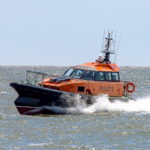The race is on for new technologies to power the maritime market to meet with future regulations, writes Samantha Fisk. Can hybrid be a clear winner, or will it be just a short-term solution?
The adoption of hybrid technology for propulsion system is starting to take off in the workboat industry with Goodchild Marine[ds_preview] delivering the first of its latest hybrid designs, the ORC 136.HY, to the Port of London Authority (PLA).
»We expect that through the power train, hull design and lower weight, the hybrid cutter will use less than 10% of the fuel used by our current pilot vessel, with carbon dioxide emissions similarly reduced. That should see us going from using 86,000 l of fuel for our pilot cutter operations a year to around 7,000 l,« explains PLA chief executive, Robin Mortimer.
Tony Birr, business development manager, Goodchild Marine highlights that hybrid technology will bring a lot of benefits to the market, where there is still hesitancy from switching from reliable diesel-powered engines to more environmentally-friendly solutions. The main element of hybrid technology is that it brings extra redundancy, which is a massive benefit to these types of vessels that need to operate in variable conditions.
Birr adds that to make the ORC 136.HY the design started with the hull form, as you need to have an efficient hull form to compensate for loss through extra weight of the battery systems that are being installed. »Even though batterie systems have been reduced in weight and size, you are still adding 2t which reduces speed«, says Birr.
The design also needs to be flexible, which is why Goodchild Marine has opted to adapt its 136 design for this project. Hull efficiency is the key to optimum efficiency gains highlights Goodchild Marine, which was the starting point for the Norfolk-based boatbuilder.
However, John Haynes, MD, Shock Mitigation opines that hybrid technology will not be for everyone in the market, adding that for vessels that need speed, hybrid may not be the solution. The crux of the matter for some may come down to an issue of speed versus efficiency and also which of these will bring reduced costs. He notes that vessels that are operating in the offshore wind market may not have the luxury in slowing down, where »money is business«, and so would probably not be a solution for that market.
As highlighted by Birr, Haynes also notes that the key point of hybrid systems is that they have better redundancies, which is a key driver for the rest of the market. Along with hull forms, such as free running hulls and matching power with hull design, hybrid does look to be a likely candidate to meet with the regulatory and technical challenges of the future.
Haynes highlights projects such as the yacht »Savannah«, designed by Feadship and powered by Corvus batteries. This vessel will be able to sail into protected waters. Another yacht project from PlanetSolar saw the largest lithium-ion battery installed onboard the solar powered vessel »Turanor«. Powered by 537m2 of solar panels, the vessel circumnavigated the globe. Costing 26mill. $, the solar powered vessel measures 30.78m in length and is capable of carrying 50 passengers.
The challenge that lies immediately ahead for the industry is to overcome the hesitancy to adopt technology that is being developed, Haynes adds that »the industry needs to get onboard with the technology to help it develop for our needs.«
Switching over to hybrid technology is slowly starting to happen with more propulsion manufacturers such as Torqueedo, Veth and Ecospeed looking at different propulsion arrangements for hybrid set ups, along with new and more adaptable units to work within those set ups. Doosan has just launched its latest 4L126TI diesel engine that can be adapted to hybrid if required with a hybrid version, due to be launched within the next year.
Haynes notes one valuable point about the hybrid set up in that »hybrid costs more up front, but there are more savings over time.« Will the maritime market be able to adjust to this new approach along with the demands from regulations and adapting to the technology?
Samantha Fisk
















